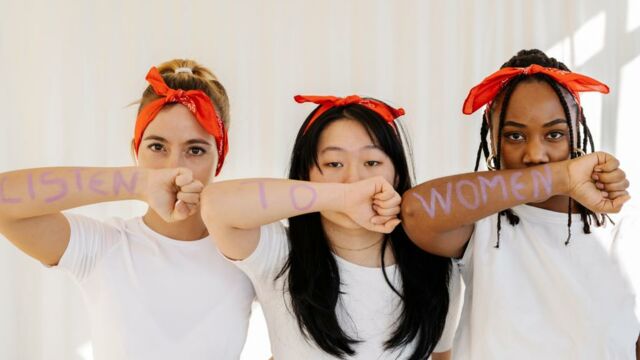In 2014, Chimamanda Ngozi Adichie published a book-length essay called We Should All Be Feminists. In it, Adichie shares anecdotes and what being a feminist means to her. One of her major points is that 'feminist' is not an insult or pejorative term, but a label everyone should embrace. The essay, which was adapted from Adichie’s Ted Talk in 2012, garnered so much attention that Beyonce included audio from the talk in her widely-celebrated song ***Flawless. The unexpected song feature brought feminist ideology into the spotlight of the historically-patriarchal music industry and sparked conversations about equal rights.
Discover our latest podcast
What is feminism?
Feminism has always been a deeply misrepresented movement even though it is simply the belief that men and women deserve equal rights as humans. In most social and political movements, feminism takes centre-stage and has won women the right to vote, hold public office, and receive education among many others. Since it has existed for centuries, it has taken on many forms throughout the years, which are organized into 'waves.'
The first wave of feminism was focused on receiving basic rights in society, such as women’s suffrage, while the fourth wave of feminism has been focused on intersectionalism and rape culture. To be clear: there is no correct way to be a feminist, but the foundation of feminism should always be advocation, empowerment, and equality.
History of feminism
The word feminism derives from the French word 'féminisme,' which was coined in 1837 by utopian socialist Charles Fourier. The word first appeared in France and the Netherlands in 1872, Great Britain in the 1890s, and the United States in 1910. Feminism has always been dependent on the time period, culture, and country of the movement. The first wave of feminism began in the 19th century and lasted until the early 20th century. Many feminists focused their efforts on legislation and equal representation in marriage, parenting, and property ownership. In 1839, women were given the right of custody of their own children for the first time. For the next few decades, many landslide decisions were made in favour of women’s rights.
Second-wave feminism took place in the 1960s-1980s and focused on more than just enfranchisement. Instead of fighting for basic rights, second-wave feminists advocated for greater representation in issues of sexuality, reproductive rights, and the workplace.
Third-wave feminism, born in the early 1990s, has roots in punk culture. Lasting until the 2010s, the third-wave of feminism championed ecofeminism, intersectionality, and transfeminism, and is often criticized for its lack of cohesion. To many others, however, this is part of the movement’s appeal.
Where are we now?
The fourth-wave of feminism came around 2012 when social media changed the ways people communicated. According to many scholars, the fourth wave of feminism can be defined by its demand for justice, mostly in response to sexual assault and violence against women. The #MeToo Movement made waves in 2017 following the Harvey Weinstein scandal. Time magazine even gave their 2017 Person of the Year spot to the 'silence breakers,' the spirited revolutionaries that demanded accountability from the men who abused their positions in power.
Today, feminists continue the fight for equity worldwide.
Key figures
History is full of powerful women paving the way for future generations. Sojourner Truth made her mark on the world by being a courageous advocate for gender and race equality. Truth, who was born a slave, reclaimed her identity in 1843 when she chose her own name. She is also the first African American woman to win a lawsuit in the United States when she won her son’s freedom.
The second-wave brought with it countless scholars, like the brilliant Bell Hooks, who helped make theories of feminism accessible to everyone. Naomi Wolf shifted the dialogue during the third-wave of feminism when she published The Beauty Mythin 1991. Wolf explains that beauty is a social construct that is controlled by men, which was so groundbreaking it earned itself a spot on the New York Times’ list of Most Influential Books of the 20th Century.
In 2006, Tarana Burke used 'Me Too' for the first time on Myspace. Burke, the founder of the Me Too movement, wanted women to feel supported when breaking their silence. Even if she didn’t realize it at the time, Burke planted seeds of revolution, and we’re witnessing them blossom in real time.
How can I be a feminist?
- Point out sexism when you see it. The easiest way to start is by eliminating micro-aggressions women experience every day. If you hear or see something sexist, call the person out and educate them on why it’s hurtful.
- Listen to women. Instead of speaking over women, listen to them. Let women tell you their experiences, struggles, and opinions without fear of judgment. The best way to learn and grow as an ally is to give space to women and show support however they deem necessary.
- Empower women. Women, especially women of color, are often passed up for opportunities at a much higher rate than men. Uplift women through emotional, physical, and financial support when you can—share new business opportunities, celebrate women’s successes and spread positivity.















